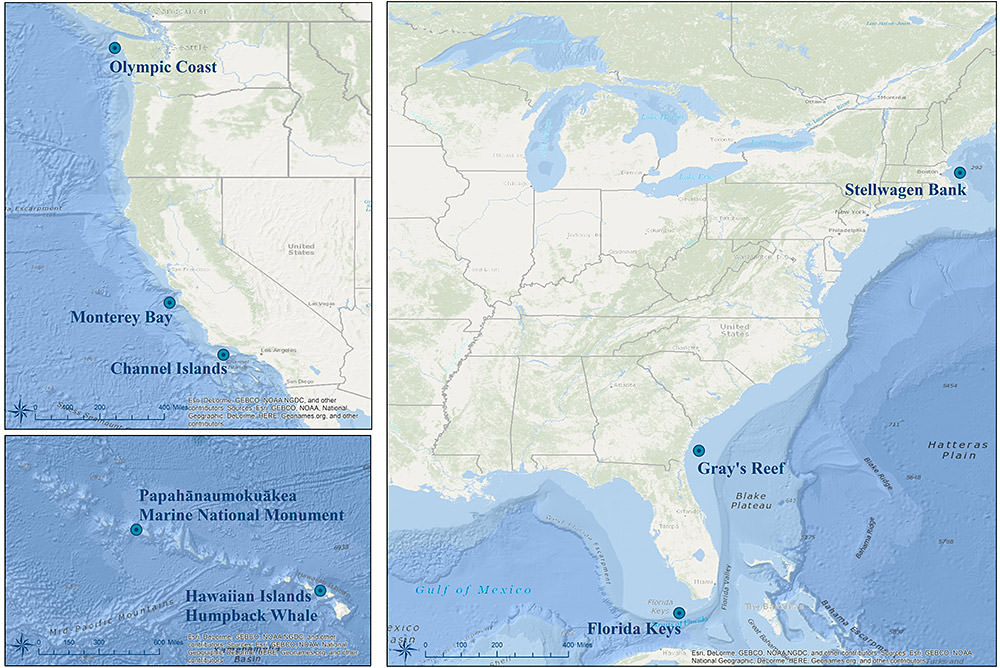Atlantic Cod Sound Production Recorded at SanctSound Site SB03_04
This record represents the Atlantic cod sound production detected from raw passive
acoustic data. All acoustic data were processed using the automatic grunt detector
and recogniser for Atlantic cod. This method uses a two-stage hypothesis testing algorithm
that includes detecting and recognizing all grunt-like sounds. Detector output was
manually verified, and false positives are removed. These data were recorded at SanctSound
Site SB03_04 between June 01, 2019 and August 02, 2019.
- Cite as: NOAA Office of National Marine Sanctuaries and U.S Navy. 2021. Atlantic Cod Sound Production Recorded at SanctSound Site SB03_04, SanctSound Data Products. NOAA National Centers for Environmental Information. https://doi.org/10.25921/dcxw-tf75. [access date].
- 10.25921/dcxw-tf75
- NCEI Metadata ID: gov.noaa.ncei.pad:NOAA-Navy-SanctSound_SB03_04_atlanticcod
gov.noaa.ncei.pad:NOAA-Navy-SanctSound_SB03_04_atlanticcod
| Search Data |
|
| Download Data |
|
| Distribution Formats |
|
| Ordering Instructions | Contact NCEI for other distribution options and instructions. |
| Distributor | NOAA National Centers for Environmental Information ncei.info@noaa.gov |
| Dataset Point of Contact | NOAA National Centers for Environmental Information ncei.info@noaa.gov |
| Dataset Point of Contact | Carrie Wall NCEI Passive Acoustic Archive Lead NOAA National Centers for Environmental Information pad.info@noaa.gov |
| Coverage Description | Site SB03_04 |
| Time Period | 2019-06-01T14:00:00Z to 2019-08-02T13:00:00Z |
| Spatial Bounding Box Coordinates |
West:-70.179015
East:-70.179015
South:42.2554283
North:42.2554283
|
| Spatial Coverage Map | |
| General Documentation | |
| Associated Resources |
|
| Publication Dates |
|
| Edition | Final SanctSound Data Product |
| Dataset Progress Status | Complete - production of the data has been completed |
| Data Update Frequency | As needed |
| Purpose | These data are available to the public for a wide variety of uses including scientific research and analysis. |
| Dataset Citation |
|
| Cited Authors |
|
| Principal Investigators |
|
| Publishers |
|
| Acknowledgments |
|
| Theme keywords | Global Change Master Directory (GCMD) Science Keywords
|
| Data Center keywords | Global Change Master Directory (GCMD) Data Center Keywords
|
| Platform keywords | Global Change Master Directory (GCMD) Platform Keywords
|
| Instrument keywords | Global Change Master Directory (GCMD) Instrument Keywords
|
| Place keywords | Global Change Master Directory (GCMD) Location Keywords
|
| Project keywords | Global Change Master Directory (GCMD) Project Keywords
|
| Use Constraints |
|
| Access Constraints |
|
| Other Constraints | Cite as: NOAA Office of National Marine Sanctuaries and U.S Navy. 2021. Atlantic Cod Sound Production Recorded at SanctSound Site SB03_04, SanctSound Data Products. NOAA National Centers for Environmental Information. https://doi.org/10.25921/dcxw-tf75. [access date]. |
| Fees |
|
| Processing Steps |
|
| Instrument |
|
| Platform |
|
Last Modified: 2023-06-15
For questions about the information on this page, please email:ncei.info@noaa.gov
